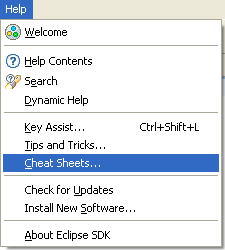
Eclipse provides cheat sheets to guide you through some of its application development processes. Each cheat sheet is designed to help you complete some task, and it lists the sequence of steps required to help you achieve that goal. As you progress from one step to the next, the cheat sheet will automatically launch the required tools for you. If there is a manual step in the process, the step will tell you to perform the task and click a button in the cheat sheet to move on to the next step. Also, relevant help information to guide you through a task is retrieved in a single click so that lengthy documentation searches will no longer be required.
A composite cheat sheet is another kind of cheat sheet that provides guidance for larger tasks or a group of related tasks.
To launch a cheat sheet from the Workbench

The cheat sheet opens as a view. At any time, only one cheat sheet is open and active. When you launch a cheat sheet, any opened cheat sheet is closed before the new one is opened. The completion status of closed cheat sheet is saved.
The cheat sheet has a toolbar at the top right edge. These icons appear in the toolbar:
 Collapses all the expanded steps
except the current step or expands steps to the last expanded state. Click to toggle between these two states.
Collapses all the expanded steps
except the current step or expands steps to the last expanded state. Click to toggle between these two states. Allows you to select and open another cheat
sheet. The completion status of the active cheat sheet is saved. Then, the active cheat sheet is closed and the
selected cheat sheet is opened.
Allows you to select and open another cheat
sheet. The completion status of the active cheat sheet is saved. Then, the active cheat sheet is closed and the
selected cheat sheet is opened. Hides the cheat sheet.
Hides the cheat sheet. Maximizes the cheat sheet.
Maximizes the cheat sheet.Note that some cheat sheets can also be launched from the welcome page by first selecting Tutorials and
then selecting one of the tutorials.
Each cheat sheet has a list of steps and it always begins with an Introduction step. When you launch a fresh cheat
sheet, the Introduction step is expanded so that you can read a brief description of the cheat sheet. To start
working with the cheat sheet, click Click to Begin 

Any time after starting a cheat sheet, you can restart from the first step by clicking Click to
Restart 
In the current step, when you click Click to Perform 


To get step-by-step instructions for that step, click the help link 

Additional help for entry fields in the tool or wizard may be available by focusing on the field (use the Tab key to position to that entry) and pressing F1.
If a current step has a Click to Skip option 


You can redo any step that you may have completed or skipped in the current cheat sheet. To redo the step, expand the step by clicking its expand icon and then clicking Click to Redo. After redoing a step, the cheat sheet will continue from the redo step.
When you finish the last step in a cheat sheet, it automatically restarts. You can also close the active cheat
sheet by clicking the close icon 